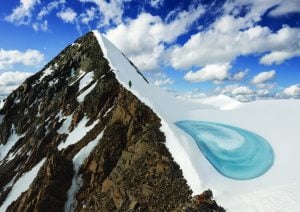We lose sunlight quickly. Thirty meters down is already pitch black. The area illuminated by the beams of our lights seems modest for our mission. Imagine mapping the Rocky Mountains at night by flashlight. As marine bilogists studying seamounts, what we do is similar but, for the full effect, imagine an unexplored Banff is hidden below three kilometers of water. Our expeditions take place hundreds of kilometers offshore of British Columbia, in Pacific Canada’s other great alpine environment, the mountains in the sea. As we descend into the ocean, illuminated passersby become alien-like. The dark abyss is speckled with the bioluminescence of lantern fish, squids and gelatinous critters of all shapes and sizes. Passing below 1,000 meters depth, we enter the ocean’s midnight zone. While the base of the mountain can be another one to two thousand meters deeper, the water is already near freezing and the pressure a hundred times greater than that experienced at sea-level.
During a seamount expedition, we routinely start our dives on a gentle-sloping flank and “climb” to the steep summit using a submersible robot — picture a gondola ride up a mountain, but equipped with banks of lights, high-resolution video and still cameras, dexterous arms, manipulators, arrays of sensors, and instruments. This equipment allows us to document and study the extraordinary life found on and around seamounts.
When lava from a large deep-sea volcanic eruption forms a giant seamount, the abrupt edifice drastically change the local conditions, creating a hidden underwater island oasis of life in the otherwise open ocean. Rocky seamounts rise kilometers above the surrounding mud that covers the majority of the world’s ocean floor. The flanks act as a ramp, driving up cold, nutrient-rich water, which can cause a cyclonic flow to form around the summit. The mixing of upwelled water at the shallower sunlit depths is the perfect recipe for phytoplankton blooms (microscopic plant-like organisms), which fuel the marine food web. These conditions attract a diversity of life, from the cold-water corals and sponges that colonize the deep pillows of volcanic lava to transient whales, sharks and seabirds that feed on the high concentration of prey. The positive effects spill over, and crabs, sea stars, fish, octopuses and many other species abound. The abundance of animals, biological diversity, and structural complexity found on a seamount can rival that of tropical coral reefs.
And because seamounts are a hotspot of life, they can play an essential role in ocean health and sustainability. However, for the same reasons, seamounts worldwide are under increasing threat from overexploitation and climate change. In the Canadian Pacific, conservation concerns include bottom-contact fishing, shipping traffic, oxygen depletion and ocean acidification. In the High Seas, concerns also include the prospect of underwater mining.






